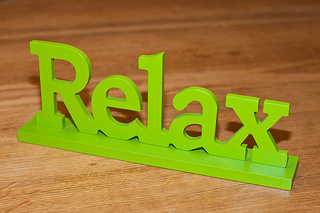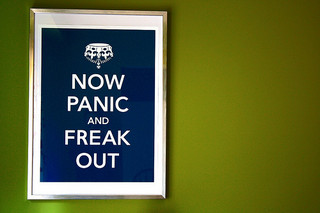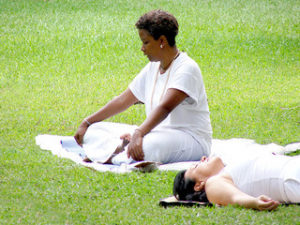
Photo credit: tacker (Creative Commons)
Note: This is the fourth post in a series on stress relief. I recommend that you read the earlier posts for a strong foundation. They cover the stress response from a physical, mental, and emotional perspective, the benefits and practice of diaphragmatic breathing, and our culture’s problem with stress pride.
Feel Better Now
Today, we’re getting to some major practice: progressive muscle relaxation (PMR). PMR involves the tension and release of muscle groups systematically, allowing the body to become deeply relaxed.

Photo credit: Lel4and (Creative Commons)
When it comes to stress relief, progressive muscle relaxation is an easy win.
What do I mean by that? Well, if you’ve been living with tension and stress, doing this even once will make you feel immensely better. It’s not like working out, where you have to wait for results.
Progressive muscle relaxation offers immediate relief.
As someone born utterly lacking in patience (and having little luck developing it), I like it things that work RIGHT NOW. Practice is a no-brainer when you feel better every time.
Over time, consistent practice means your body holds less tension, and you’ll be able to dissolve tension that does arise in nearly any situation.
Stressball Teenager Discovers Progressive Muscle Relaxation
I was first introduced to PMR at the ripe old age of 17 when I nearly had a nervous breakdown. (Sadly, that’s not an exaggeration.) I was 100% committed to getting of Dubuque, Iowa. While Forbes named Dubuque both the #1 Small City to Raise a Family and the #14 Best Small Places for Business and Careers recently (go, Dubuque!), the 80’s were a different story, particularly for a teenage girl who longed to see the world.
Senior year was the last chance to realize my Get the Hell Out Plan. I pushed to do everything possible to get into my #1 college choice: Northwestern University.
I applied early – and only to Northwestern. All my eggs in one basket. I rationalized this by saying that I’d apply to other schools if I got rejected, but whom was I kidding? If I didn’t get in, I’d be devastated.
While everyone else angled for early release and took fun electives, I loaded a full schedule of eight challenging classes – and as many extracurriculars as I could possibly fit. I survived on 4-5 hours of sleep a night and had nightmares of working at a gas station for the rest of my life. None of this pressure came from my parents. I did it all to myself.

Photo credit: kaylacasey (Creative Commons)
Then one day, I broke. I went outside between classes to blow off steam by screaming – except this time, I couldn’t stop.
I just kept screaming. And screaming. And screaming. I stood outside that December day, seeing my breath shoot out of my mouth like a steam engine as my voice pierced the cold.
When I finally stopped, I knew I was in trouble. I marched myself to my counselor’s office and turned myself in. I was falling, failing, and completely out of control.
It was the start of quite a journey (whose story I’ll save for another day). What’s relevant now is that the first thing my amazing psychologist, Dr. Barbara Woodward, introduced me to was progressive muscle relaxation.
That first night, when I popped that cassette in my boombox and followed the instructions, I could feel the tension drain from my tightly wound-up body. For the first time in over a year, I fell asleep almost immediately and slept soundly.
I was a believer.
Why Progressive Muscle Relaxation Is the Starting Point

Photo credit: emilyvalenza (Creative Commons)
Once you’re familiar with diaphragmatic breathing (go back and review if you need to), I usually recommend that people start with PMR for a couple of reasons.
First, if you’re really tense and stressed out, PMR’s immediate relief feels amazing.
Second, PMR takes advantage of the contrast effect. Lots of us habitually carry so much tension that we don’t even know what truly relaxed muscles feel like. Tensing muscles first makes the contrast apparent so you understand the difference – and you get evidence that you can voluntarily produce this relaxation response for yourself.
The Benefits of Deep Relaxation Techniques Such as PMR
To begin, PMR requires that you do diaphragmatic breathing, so you get all those benefits.
Progressive muscle relaxation has many profound benefits of its own. For the immune system, deep relaxation techniques increase helper cell activity, natural killer cells, and antibodies to ward off viruses and infection. It can alleviate pain, often as well or better than medication.
Deep relaxation practice bolsters the cardiovascular and respiratory systems. It lowers blood pressure long-term, improves blood flow to the heart, and reduces the severity of angina attacks. PMR can lower cholesterol. Asthmatics experience less emotional upset and less airway constriction, to name a few of the documented physical benefits.
Some of the mental and emotional benefits include: improved concentration, better mood control, increased self-esteem, increased spontaneity and creativity, decreased generalized (and phobic) anxiety, and reduced frequency and duration of panic attacks.
I could go on and on, but you get the idea. Progressive muscle relaxation can dramatically improve your physical, emotional, and mental health.
PMR Guidelines

Photo credit: ruurmo (Creative Commons)
To get the aforementioned bennies and to activate the relaxation response in stressful circumstances, you have to consistently practice PMR.
- Practice daily, at least once, preferably twice. If you fall asleep, sit for practice so you learn and integrate the technique. (If you have insomnia, you can listen at bedtime to fall asleep, but make sure to practice at another time for learning purposes.) Optimally, practice at the same time every day.
- Find a quiet location and get comfortable. This is your time to feel good – so sit or lie somewhere comfortable, where you won’t be disturbed. Fully support your head and neck (i.e., the chair should have a high back). Loosen tight clothing, remove jewelry, and get a blanket if you’d like.
- Adopt a calm, present mindset. Let your brain know it can take a break for a bit, and give yourself permission to release worries for this time. When your mind wanders, gently bring it back to the practice. Release any expectations of how it’s ‘supposed to’ be and allow whatever happens to happen.
Know that some days it’ll go better than others, and that’s perfectly fine. As Woody Allen said, “80% of life is just showing up.” Show up for your practice. Be observant and interested in what happens, without judgment or force.

Photo credit: Natesh Ramasamy (Creative Commons)
The Practice of Progressive Muscle Relaxation
Once you’re settled in a quiet place and comfortable position, you’ll go through a series of muscle groups in order. Here’s the pattern:
- Tense all the muscles in that group for 10 seconds. You may shake, or you may lift that part of the body off the ground or chair. That’s fine.
- Release all the tension and notice that relaxed feeling for 15-20 seconds. Let the body part sink into the chair, floor, sofa, or bed, completely relaxed, as if it’s made of lead. Focus your attention on the sensations you feel in that body part.
- Repeat, if necessary. Some areas are typically more tense than others (e.g., shoulders, neck, jaw). Repeat the tension and release for these if you notice tension remains after the first time.
- Scan previous areas to ensure tension hasn’t returned. If it has, allow it to release. If you’re unable to do this solely by focusing on the relaxation, tense the area again and release.
- Remain focused and concentrate on what’s happening. What do you notice? How do you experience the tension? The relaxation? Do you feel a marked contrast?
The Steps
- Relaxed Position: Find in a comfortable position with your head and neck supported.
- Easy diaphragmatic breathing: Take several slow, easy breaths into your belly. Use this breathing throughout the exercise.
- Right hand and wrist: Tense your right hand and wrist, making a fist and hold for 10 seconds. (It’s okay if your hand shakes.) Release the tension, allowing the hand to sink into the chair, sofa, bed, or floor. Observe (and enjoy) the feeling of relaxation for 20 seconds Follow the same process for all muscle groups below.
- Right arm: Forearm, bicep, and tricep – make a muscle pose. (Hold for 10, fully release and experience the relaxation for at least 20 seconds.)
- Left hand and wrist
- Left arm
- Scan both arms: Scan for tension and release any you notice. If you can’t drain it through focus, tense that area again and release.
- Right lower leg: Foot, calf, and shin area
- Upper right leg: Quadricep and hamstring
- Left lower leg
- Left upper leg
- Scan both legs: Release any tension through attention or another tense/relax sequence.
- Buttocks, inner and outer thighs
- Lower back
- Abdomen and chest
- Scan arms, legs, buttocks, back, and abdomen and release any tension
- Shoulders and upper back: Tense your shoulders, pulling the shoulder blades together in the back as if pinching something between them – hold and release.
- Shoulders 2: Tense shoulders by pulling up toward ears – hold and release
- Throat and neck
- Jaw: Clench your jaw – without grinding your teeth together. Hold, then release the jawbone so your lower jaw hangs slack, mouth open, tongue relaxed and down.
- Face: Scrunch your mouth, nose, eyes, and forehead tightly and hold. Completely release so that lips are soft and slightly apart, face is slack, forehead is smooth, and eyelids are soft, and eyes are quiet, unmoving beneath the lids. Make sure neck, throat, and jaw are also relaxed.
- Scan shoulders, chest, abdomen, and back. Release any tension.
- Scan arms and legs. Release any tension.
- Scan entire body, releasing any tension and getting to an even deeper state of relaxation.
- “I am calm”: Say “I am calm” silently several times as you feel the wave of relaxation moving throughout your body.
- Enjoy the feeling of relaxation for as long as you wish.
- Reconnecting: Before you get up, wiggle your fingers and toes and move your arms and legs a bit.
- Stand very slowly, especially if lying down. Your blood pressure is much lower in a deeply relaxed state, so you must give your body time to adjust.
The first few times you do this, expect that it will take about 30 minutes. Once you’re used to the routine, it should take about 15-20 minutes.
Note: The reason you say “I am calm” several times when in this state of deep relaxation is to strongly associate the phrase with the feeling. Eventually, after dedicated practice, saying this phrase will automatically release much of the tension in your body (which will come in very handy during stressful times). Pretty cool.
If you’d like a free MP3 recording of the progressive muscle relaxation script to use for your practice, see the note at the end of the post.

Photo credit: tobi_digital (Creative Commons)
Embrace the Relief
Once you feel how wonderful it is to be relaxed, you’ll be motivated to practice progressive muscle relaxation. Do it every day, at least once. Concentrate on the exercise and let go of any expectations or judgment. Get curious about what’s happening in your body and what you’re able to do. Last but certainly not least, if you experience tension during the day, tense and release those muscle groups – you’ll be amazed at how much better you feel right away!
Most of all, ENJOY!
~~~~~~~~~~~~~~~~~~~~
To receive your free MP3 of this progressive muscle relaxation exercise:
- Sign up for my mailing list (below or top right) if you haven’t already done so
- Include your request in the Comments section (below).
I’d love to hear about your experiences with progressive muscle relaxation, as well as any questions you have, so please include them in the comments.
As always, if you liked this or know someone who’d benefit, I’d appreciate your sharing this post. Thanks so much!

Wonderful article and guidelines, MB! I’d love the MP3, please and thank you!
Thank you so much, Katie – it will be coming your way shortly! 🙂
Love muscle relaxation. Thanks for the wonderful reminder Mary Beth! Feeling calm just at the thought of a dose of relaxation.
Hooray! I’m glad. 🙂
I’m a big fan of this technique; it works like a charm. Relaxing used to be extremely difficult for me, but the first time I was introduced to this exercise I was thrilled with the sensations I was experiencing. It was during pranayama at the end of a yoga class when the instructor walked us through these very steps. I thought I was relaxed from the yoga practise itself, but after her guidance I actually felt areas that were still tense (who knew?) relax into an almost loose, fluid state. It feels amazing!
Thanks for the reminder, I’ll have to do this tonight after work 🙂
Thanks, Erica – I hope it goes well for you! I have the same experience every time I do this: no matter how relaxed I am, this takes me farther.
Let me know if you’d like the guided version on MP3 – happy to send. 🙂
Wow what an in depth and informative post. I just discovered this one, so I’ll have to go back and read the other post in this series. PMR brings me back to my childhood because whenever I would have trouble going to sleep my mom would come in and tell me to start from the very bottom of my body, and systematically move upward tightening/tensing each muscle group and then releasing it. I never knew what the real name of it was. Thanks for writing this post!
Thanks, Julie! I love it that your mom did this with you as a kid – that’s amazing! I wish all parents (especially mine) had done so – it’s a tool that helps you your whole life.
I’m imrpsseed you should think of something like that
Thank you!
I can really relate to your experience senior year of high school in a small town!
I’ve done PMR before, without knowing that’s what it was. I do a lot of yoga, and I love when someone guides me through relaxation from head to toe. This sounds similar, but even more focused. I’ll be signing up for that mp3! Great series, Mary Beth!
Thanks so much, Hannah – and it’s good to know that someone understands. Man, that was a tough time…
I love to be guided as well – I go so much deeper when I don’t have to concentrate on the how-to’s. I hope you enjoy it! 🙂
Mary Beth, thanks for reminding me that I need some immediate relaxation and relief. Been so overworked these days. I’ve never tried some real deep muscle relaxation, and after reading your article, I am very intrigued. Would love to try it out one day. My wife does yoga and always talks about how deep breathing and also relaxing every muscle in the body in the “dead body pose” does wonders for stress relief. I definitely see that there is something to that. Your “steps” provide a very clear guide, so I will try it out someday together with my wife. By the way, I am so curious, did you get into your #1 choice school?
Thanks, Martin – let me know if you’d like the MP3. I’m happy to send it to you. A lot of people find it very beneficial to start with doing the PMR before doing a more passive form of relaxation such as in Savasana/corpse pose in yoga because you feel the extreme contrast and get to a deeper relaxation than you may be able to just using the mind.
As for school…. I DID get in! What a relief. I always use it as a cautionary tale with young people, however, because it was a lot of pressure. A stress management tip I got a long time ago (although not in time for that) was to always have a Plan B. 🙂
This is a wonderful technique, Mary Beth, and one I have used at various times to help me relax. I can only do the from the hips up, though, because of RLS (restless legs syndrome). If I get my legs too relaxed, the RLS kicks into high gear and I end up dancing around the room to get them settled. Fortunately I tend to hold tension in my shoulders, neck and jaw. And usually I have no problem relaxing, and then, because of narcolepsy, going to sleep. Oddly enough, there are times when being relaxed can make it easier to stay awake. Though I never know.
Susan, I have a relative with RLS, and I know it can be a challenge, to say the least, so it’s great that you know not to relax your legs too much (although I’m guessing you may have had to learn that through some trial-and-error…). It’s good that you’re able to get some relief in your upper body. I also hold tension in my shoulders, neck, and jaw – I used to have a mouthguard, but I cracked the hard plastic from clenching in the night! Fortunately, doing PMS, yoga, and other mindfulness techniques, it’s gotten a lot better….